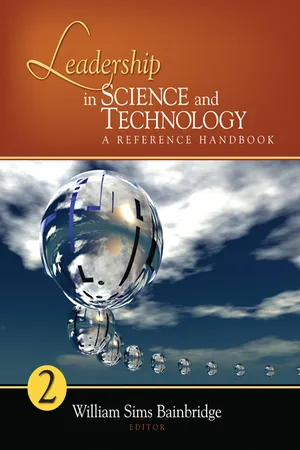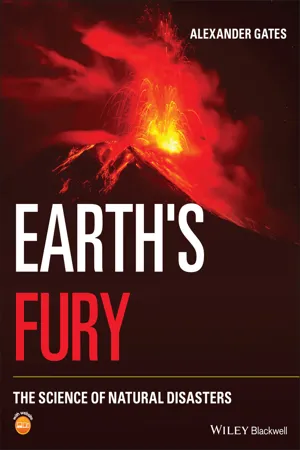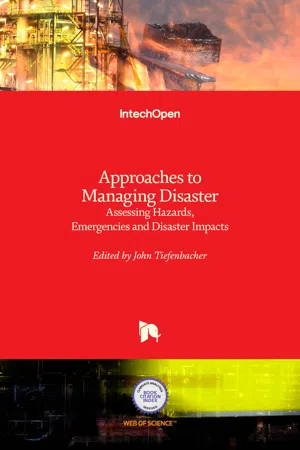Geography
Case Studies on Natural Disasters
"Case Studies on Natural Disasters" are in-depth examinations of specific natural events, such as earthquakes, hurricanes, or tsunamis, and their impacts on the environment, society, and economy. These studies provide valuable insights into the causes, effects, and responses to natural disasters, helping to inform disaster preparedness, mitigation, and response strategies.
Written by Perlego with AI-assistance
Related key terms
1 of 5
7 Key excerpts on "Case Studies on Natural Disasters"
- William Sims Bainbridge, William S. Bainbridge(Authors)
- 2011(Publication Date)
- SAGE Publications, Inc(Publisher)
512 N atural disasters grab our attention. Regardless of whether they are experienced personally, or through film, fiction, art, and news stories, they are compelling. Disasters occur through a wide range of bio-geo-physical mechanisms that directly intersect with human society, often dramatically. One way of classifying natural disasters is by type of forc-ing event. Atmospheric and meteorological events include hurricanes, dust storms, freezes, hail, heat waves, and acute drought. Hydrologic events include persistent drought, floods, and fires. Geologic events include tsunamis, earth-quakes, and volcanic eruptions. We also face disasters origi-nating from processes in outer space, including solar flares and asteroids. Other systems of cataloging disasters use defining characteristics such as duration of event, frequency of occurrence, size of economic loss, number of lives lost, suddenness of onset, disruption to social organizations and services, and difficulty of recovery. In every case, what we think of as a “natural disaster” has a strong social component. Preparation, response, and recovery efforts would be highly ineffective without directly considering social and behavioral dimensions. This holds true for disasters with seemingly no human influence or connection, for example, the disastrous New England hurricane of 1938 as well as those with a clear record of mixed causality such as Hurricane Katrina (2005) and subsequent devastating flooding. The social sciences contribute to understanding disasters and the mitigation of associated losses in many ways.- eBook - PDF
Earth's Fury
The Science of Natural Disasters
- Alexander Gates(Author)
- 2022(Publication Date)
- Wiley-Blackwell(Publisher)
1 CHAPTER 1 Earth’s Fury: The Science of Natural Disasters, First Edition. Alexander Gates. © 2022 John Wiley & Sons Ltd. Published 2022 by John Wiley & Sons Ltd. Companion website: www.wiley.com/go/gates/earthsfury Introduction to Natural Disasters CHAPTER OUTLINE 1.1 What Is a Natural Disaster? 3 1.2 Why Do People Live in Dangerous Areas? 5 1.3 What Can We Do to Stay Safe? 8 1.4 Societal Response to Natural Disasters 9 1.5 How This Book Is Organized 14 What Is a Natural Disaster? 3 Words You Should Know: Earthquake – An event in which the breakage of rock along a fault within the earth causes the release of energy in the form of seismic waves. Disaster reduction engineering – Construction practices that are designed to reduce the impact of a natural disaster. Hurricane – A highly energetic, individual tropical storm that develops over warm ocean waters. Natural disaster – A natural event that causes loss of life or property, either directly or indirectly, as a result of the aftermath. Population growth – The increase in human population over time. Tsunami – Meaning “harbor wave” in Japanese, a tsunami is an energetic ocean wave generated by a physical event (earth- quake, volcano, landslide) on the earth’s surface. Volcano – The geographic feature resulting from the release of lava and/or solid ejecta from a vent in the earth. 1.1 What Is a Natural Disaster? Humans seek to protect their lives at all costs. Major efforts and enormous amounts of money are devoted to medications and medical procedures that can increase human life by even a short amount of time. These efforts have increased the average life span worldwide and protected people from many natural threats. This increased protection has led to a sense of security among many of not having to worry about the threats, especially in the developed world. - eBook - PDF
Disasters and History
The Vulnerability and Resilience of Past Societies
- Bas van Bavel, Daniel R. Curtis, Jessica Dijkman, Matthew Hannaford, Maïka de Keyzer, Eline van Onacker, Tim Soens(Authors)
- 2020(Publication Date)
- Cambridge University Press(Publisher)
This requires a better, deeper understanding of the causes of resilience and vulnerability of societies in the face of natural hazards, to which this book, with analysis based on the historical record, hopes to contribute. 1.2 Disaster Studies and Disaster History: Connected Fields? The rise of interest in hazards and disasters as objects of scientific analysis is closely intertwined with the specifics of the Cold War period, when the US government and army became increasingly interested in how the American population would react if a (nuclear) attack occurred. In the 1950s the first research on how people reacted under extreme circum- stances, where disasters such as fires, cyclones, and earthquakes were seen as a proxy for war, was conducted mainly by sociologists, looking at 27 See for markets: van Bavel, The Invisible Hand? 10 Introduction: Disasters and History the social effects of disasters. This continued in the 1960s when the Disaster Research Center (DRC) was founded by three disaster sociolo- gists: Quarantelli, Dynes, and Haas. 28 At the same time, geographical interest in ‘natural hazards’ sparked, with a focus on building and land development. 29 Gilbert White’s ground-breaking work on floodplain management famously stated: “Floods are an act of God, but flood losses are largely an act of man.” 30 Still, these early roots of disaster studies created a field that was mainly interested in the aftermath of disaster and focused on practical knowledge for disaster management. Disasters were seen as an event – as a short rupture of normalcy. - eBook - PDF
Non-Traditional Security in Asia
Issues, Challenges and Framework for Action
- Mely Caballero-Anthony, Alistair D.B. Cook(Authors)
- 2013(Publication Date)
- ISEAS Publishing(Publisher)
85 5 Natural Disasters Mely Caballero-Anthony, Irene A. Kuntjoro, Sofiah Jamil, Pau Khan Khup Hangzo and Sadhavi Sharma Southeast Asia witnesses a number of natural disasters and did so through-out 2010, highlighting variable levels of national preparedness in dealing with disasters and illustrating the need for greater regional cooperation. This chapter looks at how governments in this disaster-prone region respond to the impact of these large scale events. What are Natural Disasters? The Centre for Research on the Epidemiology of Disasters (CRED) defines a disaster as “a situation or event which overwhelms local capacity, necessitating a request to a national or international level for external assistance; an unforeseen and often sudden event that causes great damage, destruction and human suffering”. 1 For a disaster to be entered into its Emergency Events Database or EM-DAT, at least one of the following criteria must be fulfilled: 10 or more people reported killed; 100 or more people reported affected; declaration of a state of emergency; and calls for international assistance. The EM-DAT distinguishes two generic categories for disasters: natural and technological. The natural disaster category was further divided into five sub-groups, which in turn cover twelve disaster types and more than thirty sub-types, as can be found on Table 5.1. As in previous years, in 2008 Asia remained the most affected continent by natural disasters. The region accounted for 40 per cent of all reported natural disasters and more than 80 per cent of all reported victims. Economic 86 Non-Traditional Security in Asia table 5.1 Classification of Natural Disasters Disaster Sub-Group Definition Disasters: Main Types Geophysical Events originating from solid earth. - eBook - PDF
Disaster and Recovery Planning
A Guide for Facility Managers, Sixth Edition
- Joseph F. Gustin(Author)
- 2020(Publication Date)
- River Publishers(Publisher)
Chapter 4 The Nature of Disasters Familiarity with or knowledge of the types of disasters or emer-gencies that can occur will prepare the facility manager to ef-fectively deal with the disaster or emergency occurrence. While not all emergencies are widespread disasters, there are everyday occurrences that warrant fast thinking and a cool head. TYPES OF DISASTERS Disasters and/or emergency occurrences can be classified into two distinct categories: natural or environmental, and human error or tech-nological. Natural Disasters Natural disasters include hurricanes, tornadoes, winter storms, floods, fire and earthquakes. Although fire is often the result of arson, it is covered here. Hurricanes —A hurricane is a tropical storm with winds that have reached a constant speed of 74 miles per hour or more. Hurricane winds blow in a large spiral around a relatively calm center known as the “eye.” The “eye” is generally 20-30 miles wide, and the storm may extend outward 400 miles. As a hurricane approaches, the skies will begin to darken and winds will grow in strength. As a hurricane nears land, it can bring tor-rential rains, high winds and storm surges. A single hurricane can last for more than two weeks over open waters and can run a path across the entire length of the eastern seaboard. 51 52 Disaster & Recovery Planning Areas of the United States vulnerable to hurricanes include the Atlantic and Gulf coasts from Texas to Maine, the territories in the Carib-bean and tropical areas of the western Pacific, including Hawaii, Guam, American Samoa and Saipan. Hurricanes can spawn tornadoes, which add to the destructiveness of the storm. Floods and flash floods generated by torrential rains also cause damage and loss of life. Following a hurricane, inland streams and rivers can flood and trigger landslides. When a hurricane watch is issued, the best response is to secure the physical property and be prepared to evacuate the area as soon as officials so advise. - eBook - PDF
Approaches to Managing Disaster
Assessing Hazards, Emergencies and Disaster Impacts
- John Tiefenbacher(Author)
- 2012(Publication Date)
- IntechOpen(Publisher)
6 The Impact of Natural Disasters: Simplified Procedures and Open Problems Olga Petrucci CNR-IRPI, Cosenza Italy 1. Introduction A natural hazard is a geophysical, atmospheric or hydrological event (e.g., earthquake, landslide, tsunami, windstorm, flood or drought) that has the potential to cause harm or loss, while a natural disaster is the occurrence of an extreme hazardous event that impacts on communities causing damage, disruption and casualties, and leaving the affected communities unable to function normally without outside assistance (Twig, 2007). The definition of natural disaster impact (NDI) can change according to both the aim of the study and the scientist assessing it. It can be defined as constituting the direct, indirect and intangible losses caused on environment and society by a natural disaster (Swiss Re, 1998). Direct losses include physical effects such as destruction and changes that reduce the functionality of an individual or structure. Damages to people (death/injury), buildings, their contents, and vehicles are included, as are clean-up and disposal costs. Indirect losses affect society by disrupting or damaging utility services and local businesses. Loss of revenue; increase in cost; expenses connected to the provision of assistance, lodging, and drinking water; and costs associated with the need to drive longer distances because of blocked roads are included. Intangible losses include psychological impairments caused by both direct and intangible losses that individuals personally suffer during the disaster. The Natural Disaster Impact Assessment (NDIA) is crucial in helping individuals to estimate replacement costs and to conduct cost-benefit analyses in allotting resources to prevent and mitigate the consequences of damage (UNEP-ECLAC, 2000). A general NDIA procedure has not yet been developed; several approaches are available in literature and their applicability depends on the accessibility of damage data. - eBook - PDF
Geomorphology and Natural Hazards
Proceedings of the 25th Binghamton Symposium in Geomorphology, Held September 24-25, 1994 at SUNY, Binghamton, USA
- M. Morisawa(Author)
- 2013(Publication Date)
- Elsevier Science(Publisher)
Natural hazards research is obviously an interdisci-plinary field involving a range of natural scientists with social scientists assessing the human dimension of the problems. Given the limited observed record of hazard events in most regions, a geomorphological approach, where the areal extent (and possibly the frequency) of events can be determined from the landscape, is essen-tial. The geomorphological approach may also encour-age the nature knows best approach to designing hazard mitigation strategies in balance with the dynam-ics of processes within the region. In the final analysis, occupance of hazard-prone areas is both physically and economically self-regulating. It is the function of sci-ence, as a servant of society, to identify those limita-tions and point the way toward minimizing the disastrous consequences of learning our lessons in nature's way. 36 C.L. Rosenfeld/Geomorphology 10 (1994) 27-36 References Berry, L., 1984. Desertification in the Sudano-Sahelian region, 1977-1984. Desertification Control Bulletin 10, UNEP. Berz, G., 1993. The insurance industry and IDNDR: common inter-ests and tasks. IDNDR Newsletter, #15, Osservatorio Vesuvi-ano, pp. 8-11. Bruce, J.P., 1993. Natural disasters and global change. IDNDR Newsletter #15, Osservatorio Vesuviano, p. 3. Bottorff, H., 1994. Rapid relief: GPS helps assess Mississippi River flood damage. GPS World, 5(5): 22-28. Coleman, J.M., 1969. Brahmaputra River: channel processes and sedimentation. Sediment. Geol., 3: 129-239. Cooke, R.U. and Reeves, R.W., 1976. Arroyos and Environmental Change in the American South-West. Clarendon Press, Oxford, 276 pp. Defense Mapping Agency, 1992. Digital Chart of the World. Wash-ington. 6 compact disks. Demek, J., 1972. Manual of Detailed Geomorphological Mapping. IGU Commission on Geomorphological Survey and Mapping, Prague, 344 pp. Evans, D.M., 1966. Man-made earthquakes in Denver. Geotimes, 10: 11-18. Harrold, L.L., 1971. Effects of vegetation on storm hydrographs.
Index pages curate the most relevant extracts from our library of academic textbooks. They’ve been created using an in-house natural language model (NLM), each adding context and meaning to key research topics.






